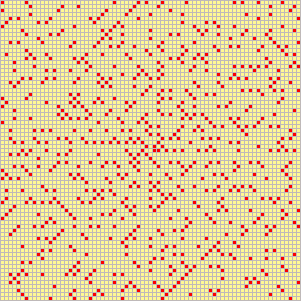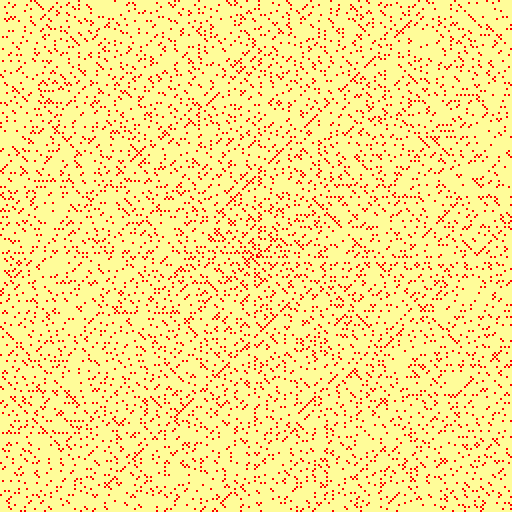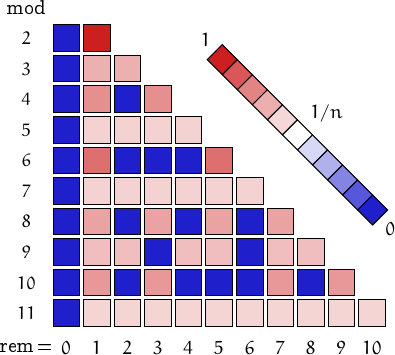By definition a number  is prime if
is prime if  and its only divisors are 1 and
and its only divisors are 1 and  itself.
itself.

 A spiral with side 256:
A spiral with side 256:
 This construction can be applied to other families of numbers, like abundant, admirable,
alternating,
apocalyptic, arithmetic,
binomials,
congruent,
deficient,
balanced,
economical,
equidigital,
evil,
hoax,
inconsummate,
junction,
lucky,
nialpdrome,
odious,
plaindrome,
practical,
pseudoperfect,
self,
super-d,
tau,
triangular,
Ulam,
wasteful and
Zumkeller numbers.
This construction can be applied to other families of numbers, like abundant, admirable,
alternating,
apocalyptic, arithmetic,
binomials,
congruent,
deficient,
balanced,
economical,
equidigital,
evil,
hoax,
inconsummate,
junction,
lucky,
nialpdrome,
odious,
plaindrome,
practical,
pseudoperfect,
self,
super-d,
tau,
triangular,
Ulam,
wasteful and
Zumkeller numbers.
 is prime if
is prime if  and its only divisors are 1 and
and its only divisors are 1 and  itself.
itself.
There are infinite prime numbers.
Stanislaw Ulam in 1963 observed that drawing the integers along a spiral (as depicted below) the prime numbers often seem to align along some diagonals. Essentially this depends on the fact that certain quadratic polynomials produce (at least in a limited range) more primes than others.



The prime numbers up to 100 are 2, 3, 5, 7, 11, 13, 17, 19, 23, 29, 31, 37, 41, 43, 47, 53, 59, 61, 67, 71, 73, 79, 83, 89, 97. more terms
Pictorial representation of remainders (mod 2, 3, ...,11) frequency. For a table of values and more details click here


Useful links
Mathworld, Prime Number
Wikipedia, Prime number
OEIS, sequence A000040
Wikipedia, Ulam spiral
Wikipedia, Prime number
OEIS, sequence A000040
Wikipedia, Ulam spiral
Prime numbers can also be... (you may click on names or numbers and on + to get more values)
a-pointer
11
13
101
+
9999993463
aban
11
13
17
+
999999000961
alt.fact.
19
101
619
+
3301819
alternating
23
29
41
+
989898989
amenable
13
17
29
+
999999937
apocalyptic
157
251
443
+
29989
arithmetic
11
13
17
+
9999991
balanced p.
53
157
173
+
9999997543
Bell
877
27644437
bemirp
1061
1091
1601
+
199999069901
c.decagonal
11
31
61
+
999995100781
c.heptagonal
43
71
197
+
999977610703
c.pentagonal
31
181
331
+
999977762881
c.square
13
41
61
+
999982234201
c.triangular
19
31
109
+
999980205949
Carol
47
223
3967
+
274876858367
Chen
11
13
17
+
99999971
congruent
13
23
29
+
9999991
constructible
17
257
65537
Cunningham
17
31
37
+
999920001601
Curzon
29
41
53
+
199999853
cyclic
11
13
17
+
9999991
d-powerful
43
89
283
+
9993623
de Polignac
127
149
251
+
99999839
deficient
11
13
17
+
9999991
dig.balanced
11
19
37
+
199999777
economical
11
13
17
+
19999999
emirp
13
17
31
+
199999931
equidigital
11
13
17
+
19999999
esthetic
23
43
67
+
898989898987
Eulerian
11
1013
15619
+
67108837
evil
17
23
29
+
999999937
fibodiv
19
47
61
+
8613332801
Fibonacci
13
89
233
+
2971215073
Friedman
127
347
2503
+
995347
Gilda
29
683
997
+
271953103
good prime
11
17
29
+
199968539
happy
13
19
23
+
9999991
hex
19
37
61
+
999962694781
Hogben
13
31
43
+
999999000001
Honaker
131
263
457
+
999843421
house
271
hungry
17
2003
iban
11
17
23
+
777743
iccanobiF
13
4139
9291169663
idoneal
13
37
inconsummate
173
383
431
+
999953
Jacobsthal
11
43
683
+
715827883
junction
101
103
107
+
99999259
katadrome
31
41
43
+
98765431
Kynea
23
79
1087
+
68720001023
Leyland
17
593
32993
+
8589935681
lonely
23
53
211
+
491856414677
Lucas
11
29
47
+
119218851371
lucky
13
31
37
+
9999823
m-pointer
23
61
1123
+
711611111111
magnanimous
11
23
29
+
608844043
metadrome
13
17
19
+
23456789
modest
13
19
23
+
1999633333
Motzkin
127
15511
nialpdrome
11
31
41
+
999999999961
nude
11
oban
11
13
17
+
997
odious
11
13
19
+
999999893
Ormiston
1913
1931
18379
+
1999996897
palindromic
11
101
131
+
99999199999
palprime
11
101
131
+
99999199999
pancake
11
29
37
+
999997083367
panconsummate
11
23
31
+
1291
pandigital
11
19
partition
11
101
17977
+
228204732751
pernicious
11
13
17
+
9999991
Perrin
17
29
277
+
1442968193
persistent
10123457689
10123465789
10123485679
+
98876532401
Pierpont
13
17
19
+
880602513409
plaindrome
11
13
17
+
788888888899
primeval
13
37
107
+
100123456789
Proth
13
17
41
+
999977648129
repdigit
11
repfigit
19
47
61
+
1084051
repunit
13
31
43
+
999999000001
self
31
53
97
+
1000000087
self-describing
10153331
10173133
10233221
+
622929272627
sliding
11
29
101
641
Sophie Germain
11
23
29
+
10000000343
star
13
37
73
+
999991228573
straight-line
4567
76543
23456789
strobogrammatic
11
101
181
+
699908806669
strong prime
11
17
29
+
99999959
super-d
19
31
107
+
9999931
tetranacci
29
401
773
5350220959
tribonacci
13
149
trimorphic
251
499
751
+
574218751
truncatable prime
13
17
23
+
999631686353
twin
11
13
17
+
999999193
uban
11
13
17
+
1000000000039
Ulam
11
13
47
+
9999877
undulating
101
131
151
+
91919191919
upside-down
19
37
73
+
99998521111
weak prime
13
19
23
+
99999971
weakly prime
294001
505447
584141
+
99999446179
Wieferich
1093
3511
Woodall
17
23
191
+
824633720831
Zuckerman
11
zygodrome
11
11177
11777
+
999999988811